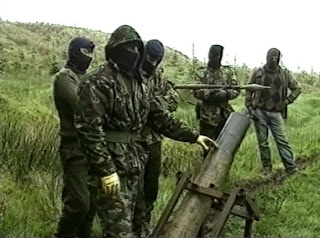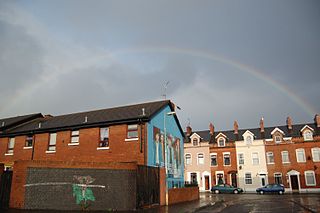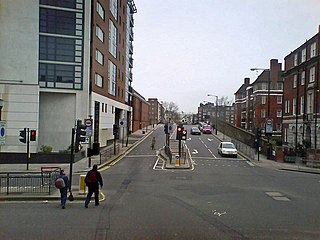
The Troubles were an ethno-nationalist conflict in Northern Ireland that lasted for about 30 years from the late 1960s to 1998. Also known internationally as the Northern Ireland conflict, it is sometimes described as an "irregular war" or "low-level war". The conflict began in the late 1960s and is usually deemed to have ended with the Good Friday Agreement of 1998. Although the Troubles mostly took place in Northern Ireland, at times violence spilled over into parts of the Republic of Ireland, England, and mainland Europe.
Bloody Friday is the name given to the bombings by the Provisional Irish Republican Army (IRA) in Belfast, Northern Ireland on 21 July 1972, during the Troubles. At least twenty bombs exploded in the space of eighty minutes, most within a half-hour period. Most of them were car bombs and most targeted infrastructure, especially the transport network. Nine people were killed: five civilians, two British soldiers, a Royal Ulster Constabulary (RUC) reservist, and an Ulster Defence Association (UDA) member, while 130 were injured. The IRA said it sent telephoned warnings at least thirty minutes before each explosion and said that the security forces wilfully ignored some of the warnings for their own ends. The security forces said that was not the case and said they were overstretched by the sheer number of bombs and bomb warnings, some of which were hoaxes.
This is a chronology of activities by the Provisional Irish Republican Army (IRA) from 1970 to 1979.

From 1969 until 1997, the Provisional Irish Republican Army (IRA) conducted an armed paramilitary campaign primarily in Northern Ireland and England, aimed at ending British rule in Northern Ireland in order to create a united Ireland.

The 1973 Old Bailey bombing was a car bomb attack carried out by the Provisional IRA (IRA) which took place outside the Old Bailey Courthouse on 8 March 1973. The attack was carried out by an 11-person active service unit (ASU) from the Provisional IRA Belfast Brigade. The unit also exploded a second bomb which went off outside the Ministry of Agriculture near Whitehall in London at around the same time the bomb at the Old Bailey went off.
On Tuesday evening 18 November 1975 an Irish Republican Army (IRA) unit nicknamed the Balcombe Street Gang, without warning, threw a bomb into Walton's Restaurant in Walton Street, Knightsbridge, London, killing two people and injuring almost two dozen others.
The 1987 Rheindahlen bombing was a car bomb attack on 23 March 1987 at JHQ Rheindahlen military barracks, the British Army headquarters in West Germany, injuring thirty-one. The large 300 lb (140 kg) car bomb exploded near the visitors officers' mess of the barracks. The Provisional IRA later stated it had carried out the bombing. It was the second bombing in Rheindahlen, the first being in 1973, and the start of the IRA's campaign on mainland Europe from the late 1980s to the early 1990s. Although British soldiers were targeted, most of the injured were actually German officers and their wives.
The 1994 Heathrow mortar attacks were a series of homemade mortar bomb attacks targeted at Heathrow Airport carried out by the Provisional IRA. Over a five-day period, Heathrow was targeted three times by the IRA, which fired 12 mortar rounds. Heathrow was a symbolic target due to its importance to the United Kingdom's economy, and much disruption was caused when areas of the airport were closed over the period due to the IRA attacks. The gravity of the incident was heightened by the fact that Queen Elizabeth II was being flown back to Heathrow by the RAF on 10 March.
The Battle of Lenadoon was a series of gun battles fought over a six day period from 9–14 July 1972 between the Provisional IRA and the British Army. It started on Thursday, 9 July 1972 in and around the Lenadoon Avenue area and spread to other places in Belfast. Loyalist paramilitaries and the Official Irish Republican Army were involved in some of the incidents. 28 people in total were killed in Belfast according to the CAIN: Sutton Index of Deaths. The violence ended a two-week truce between the forces of the British Government and the IRA.

On Thursday 9 October 1975, a bomb attack just outside Green Park Underground station in the City of Westminster, London, left one man dead and injured 20 others. The attack was carried out by volunteers from the Provisional IRA's Balcombe Street Gang. The attack occurred during a period of heightened activity by the IRA in England and in particular London and surrounding areas, since the Caterham Arms pub bombing two months earlier in August 1975.
The Balcombe Street Gang was a Provisional Irish Republican Army (IRA) active service unit (ASU) who carried out a bombing campaign in southern England in the mid-1970s. The majority of their attacks and attempted attacks took place in London and the rest in Surrey, Hampshire and Wiltshire. Between October 1974 and December 1975 they carried out approximately 40 bomb and gun attacks in and around London, sometimes attacking the same targets twice. The unit would sometimes carry out two or more attacks in one day; on 27 January 1975 they placed seven time bombs in London.
The Provisional IRA carried out two separate attacks on the same day on 1 May 1988 against British military personnel in the Netherlands which resulted in the deaths of three RAF members and another three being injured. It was the worst attack suffered by the British security forces during The Troubles from 1969 to 1998 in mainland Europe.

On 18 February 1991 two Provisional Irish Republican Army (IRA) bombs exploded at London mainline stations, one at Victoria station and the other at Paddington station, killing one person and injuring 38 other people at Victoria station. It was the IRA's second major attack in London in February 1991 after the Downing Street mortar attack eleven days earlier which was an attempt to assassinate the British War cabinet and the British prime minister John Major. It was also the first IRA attack against a civilian target in England since the 1983 Harrods bombing, marking a strategic change in their bombing campaign in England.
On 25 and 27 November 1974 the Provisional Irish Republican Army (IRA) placed several bombs in pillar boxes and one in a hedge behind a pillar box. This was a new tactic used by the IRA in England, although a similar tactic had been used in Northern Ireland during The Troubles several times previously. 40 people were wounded from five explosions in several districts.
On 22 August 1972 a bomb planted by the Provisional Irish Republican Army, an Irish republican paramilitary group, detonated prematurely at a customs office in Newry. Three IRA members killed six civilians and themselves in the explosion. The event was one of the bloodiest of 1972, the deadliest year of the Troubles.

In the late hours of 3 February and the early hours of 4 February 1973, six men, all of whom were Catholics, were shot and killed in the New Lodge area of north Belfast:
The following is a timeline of actions during The Troubles which took place in the Republic of Ireland between 1969 and 1998. It includes Ulster Volunteer Force bombings such as the Dublin and Monaghan bombings in May 1974, and other loyalist bombings carried out in the 1970s, '80s and '90s, the last of which was in 1997. These attacks killed dozens of people and injured hundreds more. Also actions carried out by Irish republicans including bombings, prison escapes, kidnappings, and gun battles between the Gardaí (police) and the Irish Defence Forces against Republican gunmen from the Irish National Liberation Army, the Provisional Irish Republican Army, and a socialist-revolutionary group, Saor Éire. These attacks killed a number of civilians, police, soldiers, and republican paramilitaries.

The Chelsea Barracks bombing was an attack carried out by a London-based Active Service Unit (ASU) of the Provisional IRA on 10 October 1981, using a remote-controlled nail bomb. The bomb targeted a bus carrying British Army soldiers just outside Chelsea Barracks. The blast killed two civilians and injured 40 people, among them 23 soldiers.
This is a timeline of the events and actions during the Troubles that were carried out in Great Britain, the vast majority of which were carried out by Irish Republican paramilitaries mainly the Provisional IRA were by far the most active but both the Official IRA and the Irish National Liberation Army, also carried out a number of attacks, which included bombings and shootings. Ulster Loyalist paramilitary groups also carried out a small number of violent actions.







